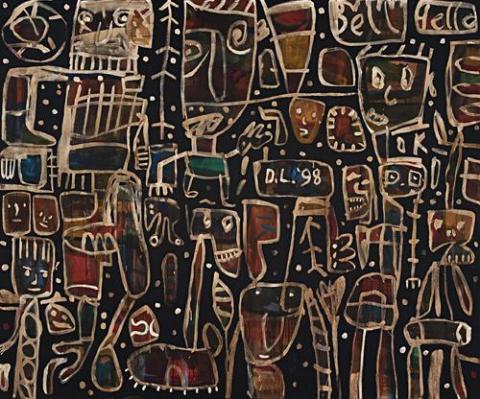PEOPLE PATTERN I, 1998
David Larwill
oil on canvas
152.5 x 182.5 cm
signed, dated and inscribed verso upper right: "PeoplePattern" I 1998 David Larwill
'Although Larwill's interest in painting was aroused by Perceval, Vassilieff, Sidney Nolan and Joy Hester (also, as he recalls, IanFairweather and Tony Tuckson), in the longer term it was European and American painters who were to exercise a more profound and lasting influence. Above all, it is in the work of Jean Dubuffet (1901-85), the French pioneer of anti-cultural art, that one finds the rationale, or more truly, 'irrationale' of Larwill's style. After seeing major examples of Dubuffet's work at both the National Gallery of Victoria and NationalGallery of Australia, Larwill looked closely at Dubuffet's art in France, Holland and other places, not forgetting the 'Art Brut' collection in Lausanne.
In important ways, therefore, Larwill's art flows directly from the art of children, primitives, schizophrenics and the insane. His own relatively anarchic and carefree view of the world took shape when he discovered his French counterpart'
Typical of Larwill's painting in the 1980s and 1990s are recognisable snatches from the vocabulary of other artists. The puppet-like creatures and masks, however, derive ultimately from Dubuffet, together with Larwill's flat, all-over zoo cage structure. While his pictures also mirror his own permissive and cooperative way of life, which involved street parties and group living, they overlap equally with a Dubuffet style 'reality.'
Larwill's pictures are painted over and over, literally layered in transparent overpainting in different colours as he searches for a good image. What goes in first does not matter since his pictures are not a battle for subject matter. Rather they express something personal and immediate about his emotional state, including on occasions, the sense of disconnection between his thoughts, feelings and actions.'1
1. Felicity St John Moore cited in McGregor, K., David Larwill, Craftsman House, Sydney, 1997, pp. 8-9
